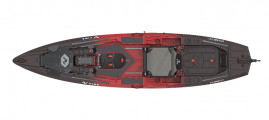In the days before the explosion of mainstream kayak fishing, it took skills and courage to fish from a kayak. After the kayak fishing revolution, fishing kayaks are now stable and comfortable enough for anyone to enjoy. Adding a motor makes kayak fishing accessible to even more anglers. And, to stay competitive in the lucrative tournament scene, a motorized kayak has almost become a prerequisite.
For many anglers, a motor opens new opportunities and brings the horizon closer.
Top picks: Best motorized fishing kayaks for 2025
The following motorized fishing kayaks have received the highest star ratings by reviewers in our Paddling Buyer’s Guide. See and review all motorized fishing kayaks here.
Best Motorized Fishing Kayaks

A.T.A.K. 120 Fishing Kayak
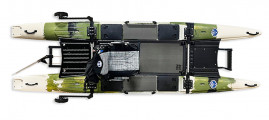
Blue Sky Boatworks 360º Pro
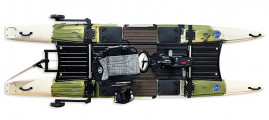
Blue Sky Boatworks Angler 360º
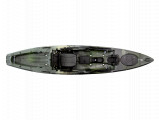
Radar 135

133X Tournament Sit-On-Top Kayak with Yak-Power
-first_product_boats.jpg)
BKC TK122 Angler Tandem Coastal Cruiser Kayak
Shop fishing kayaks with motors
Follow the links below to the Paddling Buyer’s Guide where you’ll find every motorized and motor-ready sit-on-top fishing kayak available, along with specs, prices, reviews and places to buy.
Shop by type
Shop by brand
Jackson fishing kayaks with motor
Jonny Boats kayaks with motor
Kaku fishing kayaks with motor
Native Watercraft fishing kayaks with motor
NuCanoe fishing kayaks with motor
Old Town fishing kayaks with motor
Pelican fishing kayaks with motor
Sea Eagle fishing kayaks with motor
Skanu fishing kayaks with motor
Viking fishing kayaks with motor
Wilderness Systems fishing kayaks with motor
Shopping for a used motorized fishing kayak?
Like buying a used car, when purchasing a used motorized fishing kayak, you’ll want to kick the tires and look under the hood. With any used kayak, check the hull and components for damage and completeness. Then, put the motor through its courses to make sure it is solid.
If you are purchasing a kayak with an integrated motor, be sure the motor runs in forward and reverse through the range of speeds. Also, check the motor mount for a solid fit without cracks or holes in the plastic.
When buying a kayak with an aftermarket motor, be sure the motor operates properly in both directions and through all the speeds. Also, check that the throttle and data display is working accurately. Most important, verify that the motor mount is appropriate for the motor and placed in a convenient location on the boat. An aftermarket motor mount designed to mate the specific motor with your kayak is the best option. A homemade mount cobbled together out of hardware store components should be double-checked for safety and reliability.
If you can take a test drive, make sure the boat travels straight and turns tightly. Remember, most paddle or pedal kayaks are not designed for the speed and power of an electric motor. The motor should push the kayak easily without stuffing the bow or getting squirrely in turns.
Before putting down your money, install and remove the motor from the kayak several times. First, be sure that the connection between the motor and the kayak is solid and undamaged. Then, get a feel for the steps required to load and unload the boat. You’ll likely have to remove the battery and motor before and after each trip.
The weak link on many kayaks with motors is the steering system. Turning the kayak under high pressure from a powerful motor takes its toll on cables, connections and components like the pedals and the rudder blade. Turn the rudder hard in each direction and pull and push on the parts to test the rudder for tight connections and responsive handling.
The best advice is to choose a later-model motorized kayak. In the past few years, motor kayaks have undergone huge advances in power, installation and control. Some models of motorized kayaks are no longer in production and have been replaced by updated versions that are more efficient and reliable. High miles on a used car is the same as high hours on an electric motor. If the motor has been used for years or shows signs of having had a hard life, like wear and tear on the housing and loose-fitting parts, it may be approaching the end of its life.
The battery has a limited lifespan, too. Lithium-iron batteries last far longer than lead-acid batteries but they are twice as expensive to replace. You can check the charge on a battery with a voltage meter, but it’s hard to tell the number of hours the battery has operated. Ask the owner questions about how often and how long he or she used the battery.
When it comes down to it, purchasing a used motor kayak is like purchasing a used car. Ask a lot of questions, take a test drive and inspect the kayak and motor for wear and tear. In most cases, there are no refunds so buyer beware.
For more tips on what to look for when selecting a used fishing kayak, read our article How To Buy A Used Fishing Kayak.
Motorized fishing kayak buying guide
Motorized fishing kayaks come in hundreds of shapes and sizes, but they fall into two main categories: integrated motors and add-on motors. Integrated motors are kayaks with a motor designed into the hull from the factory. Adding an electric trolling motor or brushless outboard motor to a paddle or pedal kayak offers more options for motor size and configuration but no guarantees on performance. Most recently, manufacturers are designing longer, wider and deeper kayaks specifically for matching with an aftermarket motor.
First, consider what type of kayak motor will suit your needs. A kayak with an integrated motor is easier to own and operate because the motor, battery and kayak are matched for the best performance and the rudder and controls are pre-rigged from the factory. If you’re looking for a motor kayak that is quick and easy to use with reliable performance and matching parts, a factory motorized kayak is a guaranteed good time.
If you’re looking for a kayak to motor, pedal or paddle, you should consider adding a motor to a sit-on-top kayak. Realize, once you start adding a motor, battery and rigging to a kayak that was made for paddle or pedals, you are monkeying with the boat’s performance. Read reviews and watch videos of other angler’s projects to get an idea how your combination will perform. There are a million ways to motorize a kayak, below are some ideas to get you started.
The easiest way to motorize a kayak is to install a remote-controlled, 50-pound-thrust, clamp-mount trolling motor to the stern or bow of the kayak. Anglers looking to use the motor mainly for transportation to the fishing grounds install the motor to the stern. To rely on the motor to maneuver the boat in and out of fishing holes, attach the motor to the bow. Some anglers even go for a motor in the bow and the stern for distance and tight quarters.
The most recent generation of trolling motors are controlled by a hand-held remote controls. This precludes the need to install rudder and foot pedals to control direction. Just attach the motor to the kayak and push a button on the control to turn right and left while adjusting speed in reverse and forward.
Shadetree engineers prefer to build their own bracket out of parts found at a hardware store. Unless you have a degree in busted knuckles and greasy fingernails, we suggest leaving the work of attaching a powerful electric motor to a plastic boat to the pros.
Another option is adding a brushless electric outboard. Brushless motors are designed for maximum efficiency while using the least power by placing the engine coils on the inside and the magnets on the outside, in the opposite configuration of a typical electric motor.
Brushless motors are faster, more powerful and more expensive. An electric outboard is best for traveling to and from the fishing grounds because it provides greater straight line speed but a wider turning radius than a trolling motor. In many cases, the electric outboard is paired with a matching battery and controls for easy installation and maximum performance.
To attach the motor, use a special bracket designed to mate the motor to your kayak. Several companies make brackets that save installation time and improve performance and reliability. Many kayaks are designed with inserts and a small hatch in the stern to accept a motor mount. If your kayak isn’t motor-ready, most motor mounts come with a kit to connect the motor to the boat.
Choosing the right battery is as important as finding the best kayak motor. Most electric motors run off a 12-volt battery. The cheapest option is a 12-volt, deep-cycle, marine battery. But these batteries are heavy and bulky with poor performance. A better option is a lithium-ion battery, which is lighter, stronger and easier to recharge. On the other hand, lithium-ion batteries cost up to three times more than a similar lead-acid battery.
With the battery and motor installed, you’ll need wiring and controls to connect everything. Choose cables and control boxes rated to match your motor and battery. Again, installation kits are available for battery and trolling motor combinations but it takes some creativity to fit the works in a kayak.
Try to position the heavy batteries under or near the seat to maintain the kayak’s balance. Use through-hull grommets to run the battery cables into the kayak hull. If you’re using a remote controlled trolling motor, once the battery is installed you’re good to go.
If you’re going with a tiller mount motor, you’ll need to mount the motor close enough to the seat to reach the tiller. Some electric trolling motors offer a tiller extender. Or, choose a motor mount that holds the motor off the side of the kayak closer to the seat. While the second option gets the job done, running the motor off the side of the kayak is awkward and interferes with fishing.
You can add a motor to almost any kayak, but a wide, stable boat with high capacity is best to float the battery, motor and rigging without affecting performance. Many kayaks are designed to accept a motor with flat areas and inserts in the stern and bow for the motor mount. Look for a boat with open space near the seat for a battery.
A few paddlecraft are large enough to take a gas outboard. These boats have at least 500-pounds capacity and a sturdy transom to hold the motor.
Two- to three-horsepower gasoline or propane motors are strong and reliable, but they are also noisier and stinkier than an electric counterpart. One advantage to a gas motor is refueling. It takes a few minutes to pour gas into the tank. Recharging a 12-volt battery requires several hours.
If you’re looking for an easy way to get around, check out a factory-motorized kayak. To throw a simple motor on any kayak, go with a trolling motor and bracket. For the ultimate performance, check out an electric outboard or gas motor.
-
Do fishing kayaks have motors?
Some kayaks are designed with an integrated motor. Other anglers add an aftermarket motor to their paddle or pedal kayak.
-
Can you put an electric motor on a kayak?
Electric motors are quiet, light, safe and easy to power, making them a great choice for powering a kayak.
-
What kayaks can you put a motor on?
You can put a motor on almost any kayak, but a wide kayak with plenty of capacity is the best choice. A kayak wider than 40 inches is stable to balance the motor and batteries. A boat with more than 400 pounds capacity carries the weight of added gear. Look for a kayak with a flat area in the stern or bow to mount the motor and open space near the seat to hold the battery.
Best motorized fishing kayak reviews
There’s no better way to choose a kayak with a motor than kicking the tires and taking a test drive. The staff at Kayak Angler, our sister magazine, has run the best motorized fishing kayaks. We’ve rigged the boats for fishing, loaded them with gear and hit the water.
Our testing includes miles of motoring and hours of fishing in a variety of conditions and locations. This allows us to evaluate how the boat handles and how it performs for the intended angler and conditions. If you can’t get to the paddle shop or demo day, take a test drive with our reviews of the best motorized fishing kayaks.
- Fishing Kayak Review: NuCanoe Unlimited
- Fishing Kayak Review: Wilderness Systems Recon 120 HD
- Fishing Kayak Review: Vibe Shearwater 125
- Fishing Kayak Review: Old Town Sportsman 106 Minn Kota



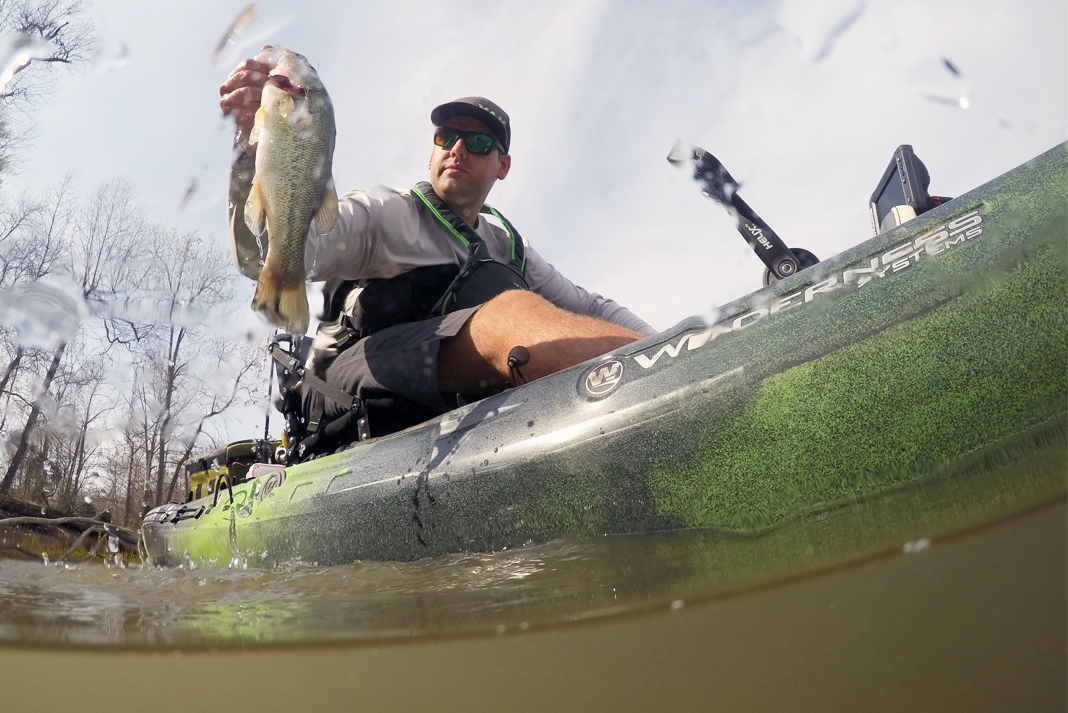
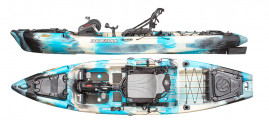
-first_product_boats.jpg)

